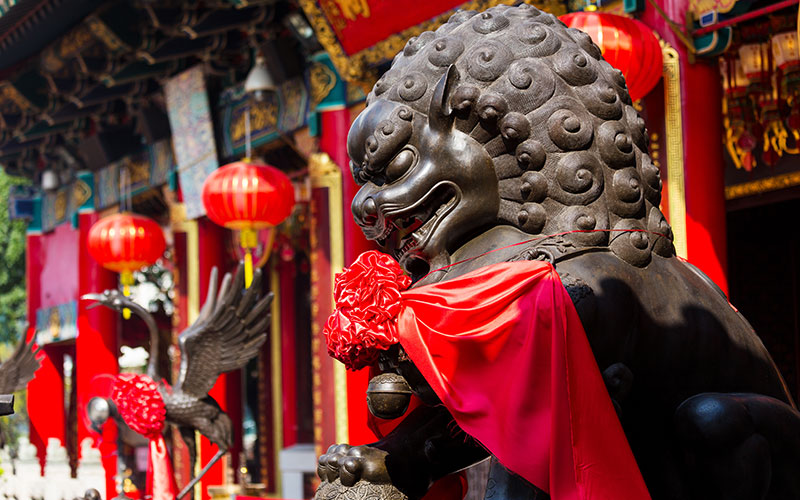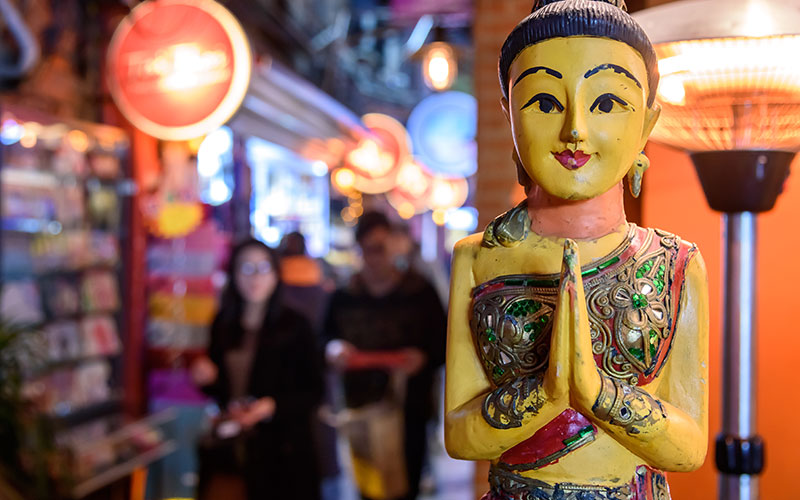
China, with its over 5000-year history, is one of the oldest civilizations in the world.
During this time, China experienced 83 dynasties of various scales and durations, with 559 rulers, among whom 397 were emperors, including one empress, and 162 were kings. These 83 dynasties established a total of 95 capitals from which they ruled over the Chinese territories. Exploring this complex and intertwined historical field and wandering through China's historical scenes is a tempting adventure.
In the 21st century BC, China saw the end of a primitive society with the founding of the Xia Dynasty. In 221 BC, Qin Shihuang founded the Qin Dynasty, the first feudal autocracy in China's history.
This was followed by more than 2000 years of feudalism until 1911. The bourgeois-democratic revolution led by Sun Yat-sen overthrew the Qing Dynasty, thereby ending the feudal imperial era.
On October 1, 1949, the People's Republic of China was founded. Today, China pursues a consistent policy of opening up and reform and possesses a socialist market economy.
Chinese culture is a collective term for all cultural assets from the Greater China region, including the areas of Taiwan, Macau, and Hong Kong. For over 5000 years, Chinese culture has significantly influenced the cultural developments in neighboring countries such as Japan, Korea, Thailand, Singapore, and many other Asian states. From today's perspective, Chinese culture, or China, is a generic term for all cultures of the 56 nationalities within the Chinese territory, including the Han, Hui, Mongols, Manchu, and Tibetans. Therefore, China is a multi-ethnic state.
Generally, it is believed that Chinese culture has three origins: the civilization of the Yellow River, the civilization of the Yangtze River, and the northern steppe culture. Chinese culture and China have crystallized from these three sources and developed into one of the highest cultures in world history.
Unlike many other cultures, Chinese cultural heritage often includes intangible assets such as legends and stories. Calligraphy, painting, poetry, and ideologies have also been passed down through millennia, while material goods from earlier dynasties have rarely survived. Chinese antiques made of porcelain, jade, or bronze are particularly rare today and are therefore persist through a high trading value.


China is characterized by diverse and complex natural landscapes: the broad and flat plains, gentle hills, high mountain ranges, broad and elevated plateaus, and basins that are high at the edges and low in the center.
Mountain and hill landscapes make up more than two-thirds of the total area of the Chinese mainland, while plains make up less than one-third. Areas that lie more than 500 meters above sea level account for three-quarters of the entire Chinese mainland.
Biologically, China is one of the countries with the richest biodiversity. There are more than 30,000 species of higher plants and 6,347 species of vertebrates in China. This corresponds to 10% and 14% of the world's plants and animals, respectively. The terrestrial ecosystem is characterized by rich diversity with 599 types. Due to its extremely rich flora and fauna, China is considered a natural gene bank of the world's biological resources.
Among the most beautiful natural parks in China are certainly Jiuzhaigou and Huanglong National Parks, the Huangshan and Wulingyuan Mountains, and Mount Wuyi.
Chinese cuisine is renowned worldwide for its diversity. Meals are often served with steamed rice. Specialties include Dim Sum, steamed snacks in small bamboo baskets, which are pushed through the restaurant on tea carts from which guests can help themselves. Peking duck is famous worldwide. Generally the Chinese cuisine is categorized into four types: Guangdong, Shandong, Sichuan, and Huai-Yang.
Guangdong cuisine is remarkable with its exquisite ingredients and fine taste. It is primarily known for its rich variety of ingredients. Besides fish and shrimp, people here also eat meat, snakes, and birds. Shandong cuisine offers a wide variety of ingredients, which are mostly braised, fried, or deep-fried. Soups are particularly well-known. Seafood such as sea cucumbers, shrimp, abalone, clams, and crabs are ingenious ingredients in the food. Sichuan cuisine is especially characterized by its spiciness.
Huaiyang cuisine stands out for its fresh and tender raw materials, careful preparation, fresh and light taste, and beautiful colors and shapes. Local freshwater crabs and other freshwater animals, as well as various vegetables, are among the specialties.
Tea has been the national drink of the Chinese for over two millennia.


China is a country of 56 nationalities. The Han nationality, accounting for nearly 92% of the total population, is China's largest nationality, while the other 55 nationalities together make up about 8%. Because these 55 nationalities have relatively few members, they are usually referred to as "ethnic minorities." The Han nationality is widespread throughout China and primarily lives in the middle and lower reaches of the Huanghe (Yellow River), Changjiang (Yangtze River), and Zhujiang (Pearl River) and in the Northeast China Plain. The remaining nationalities are mainly distributed in the vast border areas of Northeast, North, Northwest, and Southwest China. Among them, the Zhuang nationality, with 18.54 million people, is the largest minority, while the Lhoba nationality, with only 3,689 people, is the smallest nationality in terms of population.
The Han nationality has its own language and script. The Han Chinese language, generally referred to as the Chinese language, is today the widely used language throughout China and is also commonly used internationally. The Hui nationality and the Manchus also use the Han Chinese language. The remaining 53 nationalities use their own languages, and 23 nationalities have their own scripts.
Name
The Chinese call their own country Zhongguo (official name: Zhonghua Renmin Gongheguo). In the rest of the world, it is known by the name "People's Republic of China" or simply "China." The word China does not exist in Chinese itself. The name China likely derives from the ancient Chinese word Qin, the name of the Chinese principality from which the Qin Dynasty (221 – 207 BC) emerged. Through several stages and languages, the designation Qin traveled along the Silk Road to Europe. In English, it can be quite well translated as "Empire of the Middle."
Area
China's area is 9,597,985 km², making it about as large as the USA. China's north-to-south extent is 4,500 km; the east-to-west extent is 4,200 km. The coastline of all of China's sea borders amounts to 14,500 km. The territory is divided into 22 provinces, five autonomous regions, four directly governed cities, and two special administrative regions.
Capital
Beijing
Population
1.417 billion (as of 2022) - making China one of the most populous countries on Earth.
Population Density
China's population density is 150 inhabitants per square kilometer. This figure by itself is not particularly high, but it is also highly misleading. Western China, for instance, has a sparse population over a large territory. The majority of the population lives in the coastal regions, particularly in the east of the country, where the major hubs are located.
Population
Nearly 92% of the population are Han Chinese. Nonetheless, the 55 ethnic minorities ("nationalities") collectively account for well over 100 million people.

Geography
China borders more countries than any other state, sharing its borders with 14 neighbouring countries: Vietnam, Laos, Myanmar, Bhutan, Nepal, India, Pakistan, Afghanistan, Tajikistan, Kyrgyzstan, Kazakhstan, Russia, Mongolia, and North Korea. To the east and southeast, China borders the Yellow Sea, the East China Sea, and the South China Sea. High mountain ranges (Himalayas, Tianshan, Pamir) form the borders to the south, southwest, west, and northwest. Northern China is characterized by steppes and deserts.
The most important rivers are the Yangtze River (also Changjiang = long river) and the Yellow River (Huang He), along with the Lancang River (Mekong), Pearl River, Brahmaputra, and Amur.
China's geographical peculiarity lies in its numerous mountain ranges. Mountains, high plateaus, and hilly landscapes account for two-thirds of the total land area. China's terrain looks like a staircase descending step by step from west to east. The highest step is the Qinghai-Xizang-Plateau, averaging more than 4000 meters above sea level, and is known as the "Roof of the World." A special highlight in China is Mount Everest's main peak, Chomolungma. At 8848.14 meters, it is the highest peak in the world.
Economy
China is the world's second-largest economy. With over 3.2 trillion US dollars, it has the highest foreign exchange reserves globally. Thus, China has become a significant force in the global economy and, alongside Japan, the decisive economic power in the region.
Currency
Renminbi (international abbreviation: CNY or RMB, symbol: ¥). The units of the currency are Yuan, Jiao, and Fen. One Yuan equals 10 Jiao or 100 Fen. Exchange rate: 1 EUR = 7.79 CNY (as of June 2024).
It is possible to withdraw money with credit or debit cards at most ATMs. Credit cards are also accepted in good international hotels.
Government System
The socialist market economy and state system are ingrained in the constitution of the People's Republic of China. The highest state organ is the National People's Congress, the parliament of the People's Republic of China. It elects the president, the State Council (the government of the People's Republic of China), the Supreme People's Court, the Central Military Commission, and the Supreme People's Procuratorate. The election of the National People's Congress is conducted under the leadership of the Standing Committee. This means that the population elects the people's congresses at the lowest level directly, which then elect the deputies of the next higher level up to the National People's Congress. The National People's Congress is elected for five years.
National Holiday
October 1 (Founding Day of the People's Republic of China)
Religion
China is officially an atheist state. There are no official statistics on religious affiliation. Common religions include Buddhism, Daoism, Islam, Christianity, and Lamaism (in Xizang and Inner Mongolia). Additionally, the influence of traditional Chinese folk beliefs is significant. Confucianism, primarily a social ethic rather than a religion, notably influences the moral behavior of the Chinese people.
Flora and Fauna
China is one of the countries with the richest plant resources. There are over 32,000 species of higher plants alone. Almost all plant species of the northern hemisphere can be found in China. There are over 2000 edible plant species and more than 3000 that can be used medicinally. China is also one of the countries with the most animal species. Its vertebrates number alone is 6,266 species, about 10% of the world's total animal kingdom. Rare animal species native only to China include the Giant Panda, the Snub-Nosed Monkey, the South China Tiger, and the Chinese Alligator.
Climate
China's climate is with its 18 different climate zones very diverse: The west, north, and northeast have pronounced continental climates with very cold winters and hot summers. The south, on the other hand, has a subtropical to tropical climate. The best travel time for most regions is from April to mid-June and from September to mid-November.
Local Time
CET + 7 hours (standard time), + 6 hours (daylight saving time)
How to get there
There are several direct flights between China and Germany. For example, Air China flies from Frankfurt, Munich, and Düsseldorf to Shanghai and Beijing, China Eastern Airlines from Frankfurt to Shanghai, or Hainan Airlines from Berlin to Beijing. From there, travelers can continue to over 100 domestic Chinese cities. If you have time, you can also reach China by land via train. Many Chinese trains have first-class compartments. A popular entry option from Europe is the Trans-Siberian Express, which runs from Moscow to Beijing.